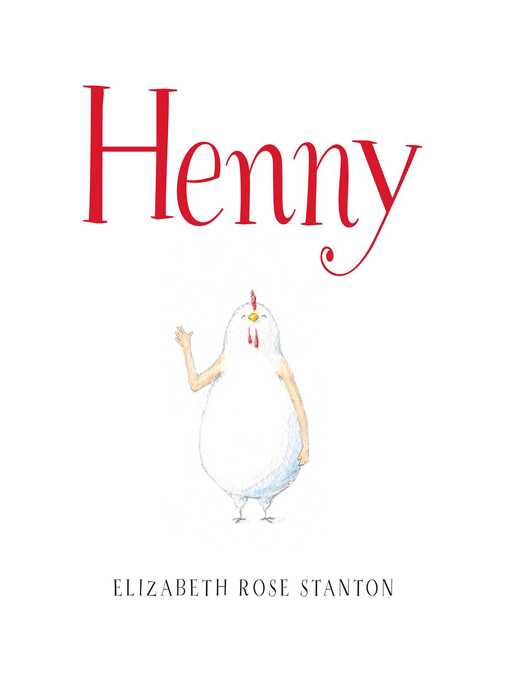
Henny
فرمت کتاب
ebook
تاریخ انتشار
2014
Lexile Score
470
Reading Level
0-2
ATOS
2.2
Interest Level
K-3(LG)
نویسنده
Elizabeth Rose Stantonشابک
9781442484382
کتاب های مرتبط
- اطلاعات
- نقد و بررسی
- دیدگاه کاربران
نقد و بررسی

October 21, 2013
Readers will do a double take at the confident chicken who waves hello from the cover of Stanton’s debut. Instead of feathery wings, Henny has skinny pink human arms and hands. Although “Henny’s mother... loved Henny anyway,” the other farm animals stare and even chortle. Henny frets, albeit in non-chickenish ways: “She worried about being right-handed or left-handed.... She even worried about things she didn’t quite understand—like tennis elbow, and hangnails, and whether she might need deodorant.” Henny eventually discovers a talent for farm chores and starts “to imagine all the other things she could do,” from hailing a cab to flying (a plane). In gentle pencil-and-watercolor sketches on an eggshell-white ground, Stanton scatters moments of quiet humor like chicken feed—Henny tries to “fit in” with a common chicken pose, folding her arms back like wings, and she bends those same elbows when she covers her ears to dampen a rooster’s crow. It’s a somewhat facile story of difference, but Stanton’s artwork marks her as a talent worth watching. Ages 4–8. Agent: Joanna Volpe, New Leaf Literary & Media.

December 1, 2013
Henny is a chicken but with human arms. (Best not overthink the hows and whys.) She likes being different from her fellow chickens when she's climbing a tree, but she doesn't like being different when the other farm animals laugh at her. In other words, she is Everychicken. Henny's disproportionately long, spindly, pinkish human arms are particularly creepy to behold, partly due to the soft, delicate nature of the debut author/illustrator's pencil-and-watercolor illustrations. They allow her certain luxuries foreign to her species, such as hugging her mother and helping Mr. Farmer with his chores. And, somewhat unsettlingly, "She liked it when they fluttered behind her like ribbons when she ran." (Sometimes her arms are shown as boneless, sometimes not.) In time, the barnyard bird begins to imagine hailing New York taxis, ice-skating, even flying a plane. Unfortunately, there's no cohesive narrative here, mostly just abundant illustrated examples of what can be accomplished with arms and hands. As Henny worries about tennis elbow and hangnails, imagines pointing or "mak[ing] a point," plugs her ears or carries a purse, readers may stop caring what Henny can or can't do. Whether or not children find a friend in Henny, this picture book needs a storyline. (Picture book. 4-8)
COPYRIGHT(2013) Kirkus Reviews, ALL RIGHTS RESERVED.

December 1, 2013
PreS-Gr 2-Born with skinny human arms instead of wings, Henny is one extraordinary chicken. Though her mother loves her unconditionally, Henny struggles with her peculiar appearance. She vacillates between enjoying having arms and worrying about fitting in. One day, as she follows Mr. Farmer around the farm, she catches an egg that he drops and embraces her uniqueness at last. Stanton's airy watercolor and pencil illustrations on expansive white backgrounds deftly capture the chick's range of emotions, from sadness about being teased by other animals to triumph when picturing herself flying a plane. The droll depictions of her activities, however, are somewhat unsettling-Henny milking a very confused cow, eating bugs with chopsticks, or crossing her arms are equal parts funny and uncanny. Giles Andreae's Giraffes Can't Dance (Orchard, 2001) and Mo Willems's Naked Mole Rat Gets Dressed (among many others) present more developed, yet still humorous takes on the subject.-Yelena Alekseyeva-Popova, formerly at Chappaqua Library, NY
Copyright 2013 School Library Journal, LLC Used with permission.

Starred review from January 1, 2014
Preschool-G *Starred Review* This Henny is no regular sky-is-falling chick. She has arms! (A helpful chart compares a normal chick with Henny: wattles, yes; combs, yes; wings, uh, no.) Henny has mixed feelings about her arms. They can flutterbut they can also drag. Should she be left-handed? Or right-handed? Should she use deodorant? All ambivalence disappears, however, when Henny gets a taste of working on the farm. Milking cows and feeding chicks empowers her, and she begins to consider all the other things she might be able to do, including picking up her grain with chopsticks and combing her comb. Ultimately, all these possibilities lead tomaybea career as a pilot. The plot is thin, but the premise is clever, and the execution is hysterical. In part, this comes from Stanton's expert depiction of Henny as fair, round, bemused, and rather feminine (except for those long hairy arms). And in part it comes from the clever, unlikely scenarios in which she places her heroine. The matter-of-fact tone of the text elevates the weirdness of the juxtapositions. For those who want a little more meat on their drumstick, this does have a good message about making the best of one's circumstances and looking on the bright side. But mostly, it's just funny.(Reprinted with permission of Booklist, copyright 2014, American Library Association.)

























دیدگاه کاربران